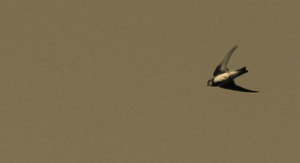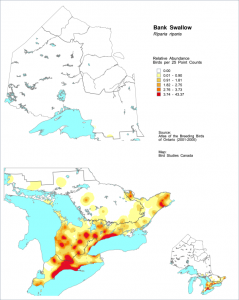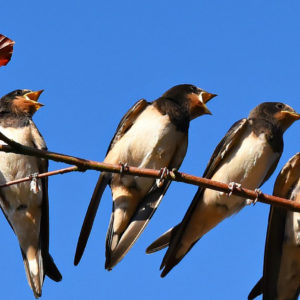More than we ‘banked’ on…

Alex MacDonald, Conservation Manager
Since the summer of 2015, Nature Canada has been working on an exciting and many-faceted project called Safeguarding At-risk Birds, Bats & Butterflies in the NatureHood, focused on the Ottawa region. The project, which is funded by the Ontario Government through the Species at Risk Stewardship Fund, includes field surveys, public education and stewardship efforts for 7 local species at risk (with their legal status listed in the parentheses): Bank Swallow (threatened), Barn Swallow (threatened), Chimney Swift (threatened), little brown bat (endangered), northern long-eared bat (endangered), eastern small-footed bat (endangered), and the monarch butterfly (special concern). Through the project we’ve been able to protect (some of) the species we love right in our backyard, while developing initiatives that can be scaled-up and replicated elsewhere through our national NatureHood program, such as the bat detector lending library or our signature NatureBlitz events. But that’s not all!
As the result of extensive surveys by our field biologist, Nathalie Paquette, this summer we collected valuable data on the local distribution of Bank Swallows. Unlike its cousins this swallow species nests in colonies consisting of large groups of burrows clustered along vertical river banks or, more recently, the walls of sand pits and quarries or deep road-cuts. The birds excavate the burrows themselves on the exposed vertical sandy walls, preferring walls that are actively eroding to those that are sloped. Our surveys this summer and last summer helped to fill in a data gap for Bank Swallow distribution in the Ottawa area and around the globally significant Lac Deschênes-Ottawa River Important Bird & Biodiversity Area (IBA), where the last targeted surveys for the species were unsuccessful and were limited to just a couple of sites. Prior to that, the last Breeding Bird Atlas for Ontario (2001-2005) showed low abundance and only a few confirmed breeding locations for the species in the Ottawa area. By all accounts Ontario’s hot-spots for Bank Swallow are the northern shorelines of Lakes Erie and Ontario, as well as a few large rivers in the southern portion of the province.
Bank Swallows are experiencing annual declines of 8.9% across Canada, resulting from threats including loss of nesting habitat, loss of foraging habitats, environmental contaminants and pollution, decreased nest productivity and climate change. In short, there’s no smoking gun and we still have a relatively limited understanding of this species and the threats it faces throughout its life cycle – from its North American breeding grounds in Canada to its wintering range throughout Central and South America, and all points in between. Locally in the Ottawa area, Bank Swallows have almost certainly suffered from habitat loss due to the development of and human encroachment on shoreline areas along local river systems such as the Rideau, Mississippi, Carp and Ottawa rivers.

Bank Swallow foraging over an Ottawa wetland (A. MacDonald)
Since 2015 our Bank Swallow surveys have uncovered almost 2000 burrows in the Ottawa region, which assuming that about 50% of the burrows at any given site are used for nesting, corresponds to about 2000 individual birds. That’s about 10% of the 20,000 individual Bank Swallows estimated to nest on the north shore of Lake Ontario and is about 0.5% of the provincial population estimated at about 410,000 individuals (from the 2016 Bank Swallow Recovery Strategy for Ontario). We’re still crunching the numbers, but these results are really encouraging! Especially when you consider that so little was currently known about actual numbers of birds in the Ottawa region. We’re excited to share these results with our colleagues at Environment and Climate Change Canada, the Ontario Ministry of Natural Resources and Forestry and Bird Studies Canada.
Stay tuned for more results of our work on species at risk in the Ottawa region and elsewhere! And if you want to help species like the Bank Swallow get the funding and attention they need, don’t forget to sign our petition here.




